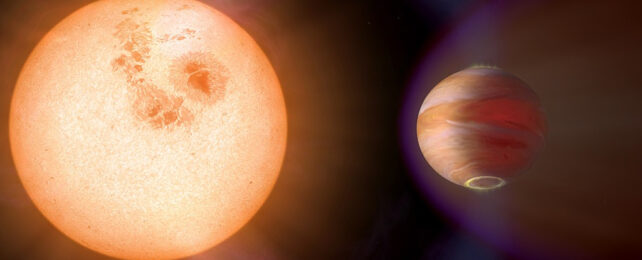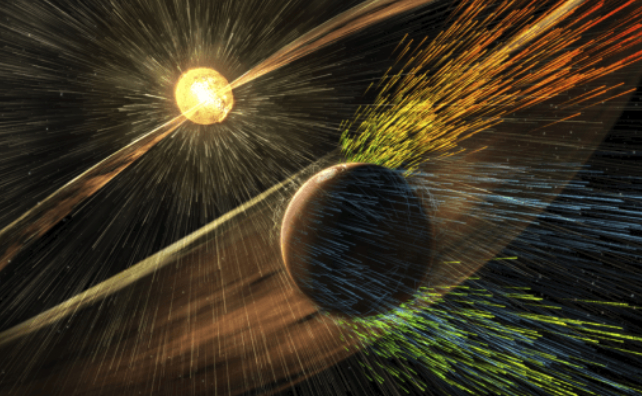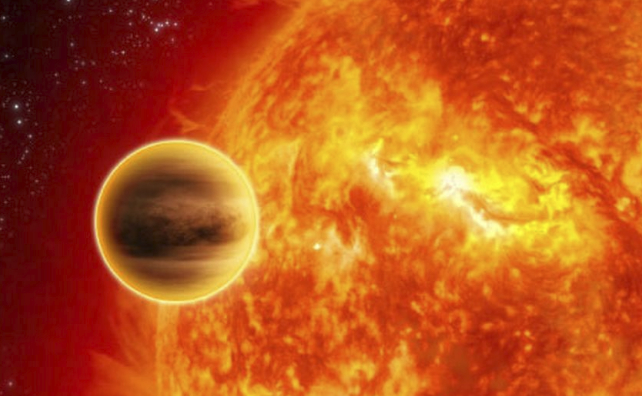ARTICLE AD
 Ultra-short period planets can be engulfed by their stars. They may be responsible for differences in metallicity between sibling stars. (NASA/ESA/A. Schaller)
Ultra-short period planets can be engulfed by their stars. They may be responsible for differences in metallicity between sibling stars. (NASA/ESA/A. Schaller)
In recent years, astronomers have developed techniques to measure the metal content of stars with extreme accuracy. With that capability, astronomers have examined sibling stars to see how their metallicity differs. Some of these co-natal stars have pronounced differences in their metallicity.
New research shows that stars engulfing rocky planets are responsible.
Co-natal stars are born in the same giant molecular cloud (GMC), though they're not necessarily in binary relationships with each other. These stars are expected to have very similar metallicities, even though no GMC is totally homogenous and small differences are common in the stars that form together. But when the differences are pronounced, there must be some other explanation.
New research titled "Metal pollution in Sun-like stars from destruction of ultra-short-period planets" suggests that rocky planets are the source of these discrepancies. The authors are Christopher E. O'Connor and Dong Lai from Northwestern University and Cornell University, respectively. The research is on the pre-print server arxiv.org and has been submitted to the AAS journals.
"Detailed studies of chemical composition among co-natal stellar pairs – stars with a common origin – reveal unexpectedly large differential abundances among refractory elements," the authors write.
The authors refer to this as pollution after a similar thing that happens in white dwarfs. The source of this pollution is rocky planets, which are rich in metals.
Ultra-short-period (USP) exoplanets orbit their stars very closely and typically complete an orbit in only a few hours. They have similar compositions to Earth and are seldom more than two Earth radii. Their origins are not clear. They could have formed further out and then migrated closer to their star, or they could be the remains of much larger planets that lost their atmosphere due to stellar irradiation.
 This artist's rendering shows a star stripping away a planet's atmosphere. (NASA/GSFC)
This artist's rendering shows a star stripping away a planet's atmosphere. (NASA/GSFC)USP planets are not very common. Only about 0.5 percent of Sun-like stars have them. They're very hot, so their surfaces are melted, and they're tidally locked to their stars.
Though uncommon, they may form in greater numbers and then be consumed by their stars.
"Short-period exoplanets are potentially vulnerable to tidal disruption and engulfment by their host stars," the authors write. Research shows that between 3 to 30 percent of co-natal, main-sequence, Sun-like (FGK) stars have engulfed rocky planets between 1 to 10 Earth masses.
There are many ways this can happen. "Many forms of violent dynamical evolution are possible in planetary systems, each potentially able to inject a planet into the star," O'Connor and Lai write. However, evidence shows that, at most, about 2 percent of single FGK stars are polluted by all violent mechanisms combined.
Astronomers have proposed three main scenarios where stars can engulf USP planets.
One is called high-eccentricity (high-e) migration. In this scenario, a proto-USP becomes very close to its star and has a high eccentricity. Because of its proximity to the star and its gravitational draw, the planet rapidly loses its eccentricity and adopts a circular orbit.
 This illustration shows a Jupiter-mass exoplanet getting perilously close to its star. If they become engulfed, they may produce a different signature on the star than a rocky planet does. (C. Carreau/ESA)
This illustration shows a Jupiter-mass exoplanet getting perilously close to its star. If they become engulfed, they may produce a different signature on the star than a rocky planet does. (C. Carreau/ESA)The third scenario is obliquity-driven migration. In this scenario, a companion planet to the USP excites the USP's obliquity and captures it in a secular spin-orbit resonance. The USP rapidly migrates towards its star, but the migration ends when the USP escapes the resonance.
The authors developed a model to predict the number of USPs that form and the time it takes for them to become engulfed. Their model can reproduce both the low observed occurrence of USPs around Sun-like stars and their polluted metallicity. Their results favour the low-e migration scenario where USPs are part of compact, multi-planet systems.
"We find that USP engulfment is a natural consequence of the low-e migration scenario. A connection between USPs and engulfed rocky planets in Sun-like stars, therefore, seems plausible," they write.
Their results show that USPs become engulfed between 0.1 and 1 gigayear after they form. If this engulfment is the main source of pollution in Sun-like stars, the authors say there's a correlation between pollution and compact, multi-planet systems.
"Some 5–10 percent of polluted stars should have a transiting planet of mass ≳ 5M⊕ and period ~ 4–12 days," they explain.
They also predict the reverse: there should be an anti-correlation between USP occurrence and pollution.
The authors point out some caveats regarding their results.
The signatures of metallicity pollution can fade over time. The metals can settle into the star, making the signal disappear. Depending on how effective that is, it could mean our understanding of how many stars are polluted is inaccurate. It could mean more than 30 percent of Sun-like stars are polluted.
The second caveat is that more violent mechanisms could inject planets into their stars. Planet-planet scattering could drive planets into engulfment, especially rocky Super-Earths. However, the authors explain that "We find only ~ 1 percent of stars can be polluted through the violent destruction of super-Earths, despite their ubiquity as exoplanets."
Their final caveat concerns Hot Jupiters (HJs). These gas-giant planets orbit very closely to their stars. Astronomers believe that HJs are destroyed by engulfment during their stars' main sequence lifetime. HJs also have a similar occurrence rate as USPs around Sun-like stars. It's a fair question to ask if they contribute to the observed metallicity pollution.
The authors say it's possible that high-eccentricity migration can drive HJs into stellar engulfment. However, they also point out that there's good reason to doubt that. "Again, an engulfed HJ may not produce a similar chemical signature to a rocky planet: the masses and bulk metallicities of HJs vary
widely," they write. All of the hydrogen and helium in HJs could also dilute the extra metals. Additionally, tidal disruption of HJs may not lead directly to engulfment. It's possible that mass transfer could reduce the HJ down to a super-Earth remnant made of the original core and a residual atmosphere.
According to O'Connor and Lai, more study is needed before we can understand how HJs might contribute to stellar pollution.
Their results also show that a main sequence star can only form one USP during its main sequence, so only one can be engulfed. In a compact system, only the innermost planet can suffer enough tidal decay to become a USP.
In their conclusion, the authors write that stars hosting USPs should have ages and kinematics similar to Milky Way field stars and should rarely show signs of previous planet engulfment. They also conclude that polluted FGK stars should host compact multi-planet systems.
This article was originally published by Universe Today. Read the original article.

 1 day ago
4
1 day ago
4 

